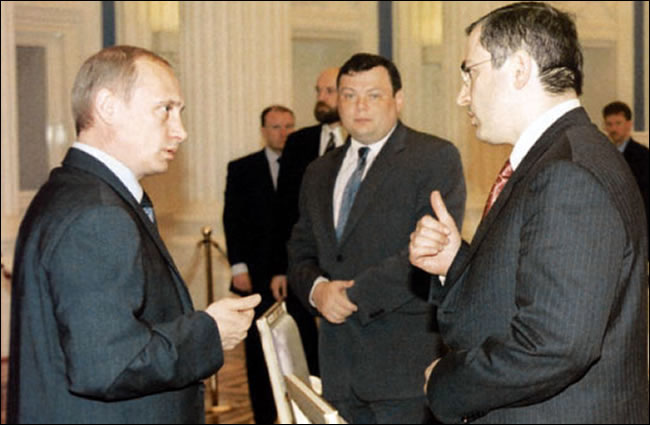Yukos
With the collapse of the Soviet Union in 1991, Russia was left with huge state-owned industries, many of them run by ineffective ‘red managers’ resistant to modernisation, and plagued by corruption and organised crime.
In 1996, Khodorkovsky and his business partners invested in a majority stake in Yukos at a cost of $309 million, the price set by the state in the privatisation process under the Yeltsin administration’s ‘loans for shares’ programme, through which investors lent the state money in return for the right to purchase state assets. At the time, Yukos did not look to be such a wonderful deal. Saddled with debts of between $2-3 billion (read more in The Yukos Library), Yukos was producing just half a million barrels of oil per day, compared to the 1.4 million barrels it had been pumping in 1987, at a cost of up to $12 per barrel, which was more than the then selling price.
Russia prohibited foreign investors from acquiring assets in its oil industry. In fact, few investors had any appetite for Russian assets due to the many risks inherent in Russia in the 1990s, including the prospect of a return to power of the communist party in the 1996 presidential election. In the months prior to the election, according to polls, President Boris Yeltsin lagged far behind communist leader Gennady Zyuganov, who had announced that he would reverse privatisations if elected.
Although in the end Yeltsin was re-elected, matters for Yukos worsened with the 1998 Russian financial crisis. The price of oil was $8 per barrel, and the production cost was $12 per barrel. Demand on the domestic oil market plummeted and exports were blocked. There was no money to pay salaries or to pay down debts.
With his partners, Khodorkovsky implemented an historic turnaround based on best international business practice – looking for efficiencies wherever possible. In the span of just a few years, they reduced per barrel costs to $1.5 and increased production to over one million barrels per day.
In 2002, Vedomosti, Russia’s leading business daily, jointly published by the Financial Times and the Wall Street Journal, awarded Khodorkovsky its annual “Entrepreneur of the Year” prize. Yukos was the envy of Khodorkovsky’s peers and many of his contemporaries began plotting the “Yukosisation” of their own companies. Shares in Yukos could be acquired not only in Russia but also on the major stock exchanges of Europe and the United States (Yukos was considering a full floatation on the New York Stock Exchange). By mid 2003, a merger with Sibneft had been agreed, and talks for selling a major stake to Exxon Mobil or Chevron were well advanced.
By 2003, Yukos and its subsidiaries had a market capitalisation of $21 billion, and produced 20 per cent of Russia’s oil – the equivalent of 2 per cent of world production. The company had become the second-largest taxpayer in Russia after the state gas monolith Gazprom, contributing 4.1 per cent of the Russian federal budget.
President Putin himself congratulated Yukos on its 10th birthday in 2003. He was quoted as saying: “Competently employing modern scientific and technical achievements, Yukos is confidently moving on a trajectory of stable growth.”

